For the last few years I have bailed on the Green-flowered (disappointments) Helleborines in north Kent, but with two major trips away this spring and summer, several other species also went unseen by me: Greater Butterfly, Heath Spotted and Early Marsh I passed on, even when I did have tome to go, and Musk Orchids escaped my orchid eye for the first season. I believe there was just the single plant at PGD this year, a friend did see and photograph it.
Sadly, the three spikes of Serapias vomeracea all failed this year. Coming a year after they mysteriously died in 2022just before flowering, this is frustrating. And disappointing. A spike did form, but turned black and apparently rotted. If the rot went down to the rhizome, then the plant or plants almost certainly have died. It was a very wet spring, and the site is overgrown too, meaning the plant, used to growing on the poor soils of the eastern Med, were just crowded out and could not survive the rain and damp conditions that 2023 brought.
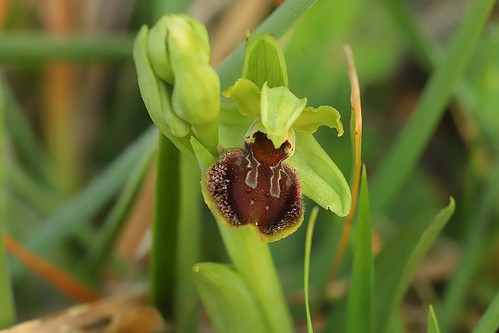 Other than that, was a good season for most other species, with the best for Ophrys sphegodes at Samphire, with a late burst after the rain bringing out impressive numbers of spikes. How different it was on April 9th, when just two plants found flowering at the base of the cliffs, and one of those had been eaten by slugs. Along the metalled track, very few rosettes, let along spikes seen until into May, when numbers did explode.
Other than that, was a good season for most other species, with the best for Ophrys sphegodes at Samphire, with a late burst after the rain bringing out impressive numbers of spikes. How different it was on April 9th, when just two plants found flowering at the base of the cliffs, and one of those had been eaten by slugs. Along the metalled track, very few rosettes, let along spikes seen until into May, when numbers did explode. Also on the 9th, the first flowering spike of Early Purple, seen at Earley Wood, was seen. Just a single flower on a single spike, but it counts.
Also on the 9th, the first flowering spike of Early Purple, seen at Earley Wood, was seen. Just a single flower on a single spike, but it counts.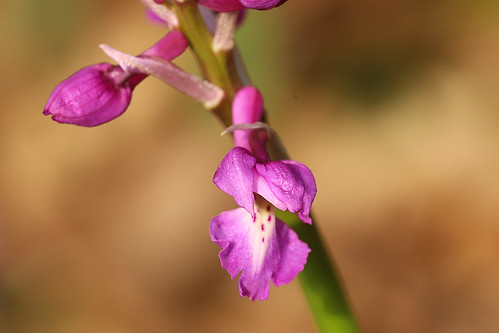 The last two weeks of April took Jools and I to Spain so I could chase butterflies. I was to see two species there: the first, a weedy Early Purple in a woodland clearing in central Spain, but the second, the fabulous Dactylorhiza sambucina, seen in both its colour forms: red and yellow, in an Alpine meadow high in the Pyrenees.
The last two weeks of April took Jools and I to Spain so I could chase butterflies. I was to see two species there: the first, a weedy Early Purple in a woodland clearing in central Spain, but the second, the fabulous Dactylorhiza sambucina, seen in both its colour forms: red and yellow, in an Alpine meadow high in the Pyrenees.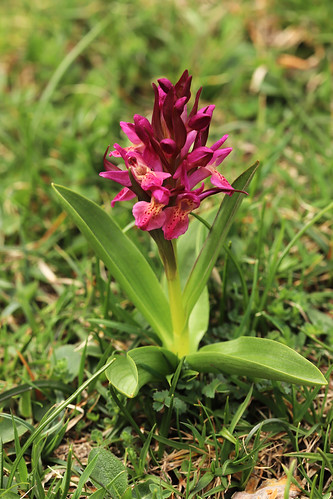
 So, back home for the beginning of May, to find that the season had exploded with the prolonged period of cold nights having come to an end. On the 5th, I snapped this Lady Orchid in which a female Crab Spider lay in wait: a true beauty and the beast.
So, back home for the beginning of May, to find that the season had exploded with the prolonged period of cold nights having come to an end. On the 5th, I snapped this Lady Orchid in which a female Crab Spider lay in wait: a true beauty and the beast. It was another wonderful year for Fly Orchids, with spikes seen all over Yockletts Bank, among the huge number of Lady Orchids there too.
It was another wonderful year for Fly Orchids, with spikes seen all over Yockletts Bank, among the huge number of Lady Orchids there too. 8th May saw me going to Marden for the annual display of Green-winged. The car park was closed all season due to flooding and mud caused by the wet Spring, so I went early morning and had all three paddocks to myself, and can report that the paddock nearest the car park has greatly increased numbers of spikes too.
8th May saw me going to Marden for the annual display of Green-winged. The car park was closed all season due to flooding and mud caused by the wet Spring, so I went early morning and had all three paddocks to myself, and can report that the paddock nearest the car park has greatly increased numbers of spikes too.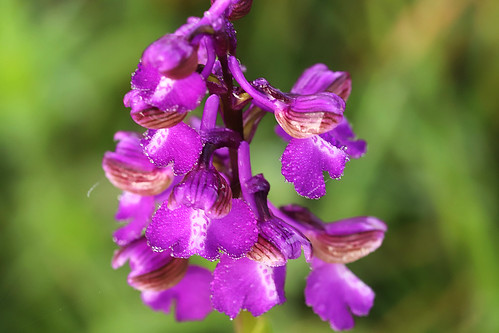 On 20th May, Man Orchids at Lydden were starting to open, and due to great site management, numbers there are over double from when I first went a decade ago.
On 20th May, Man Orchids at Lydden were starting to open, and due to great site management, numbers there are over double from when I first went a decade ago.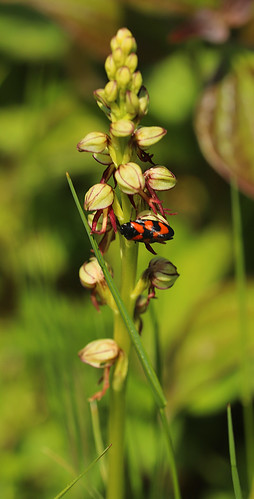 Up on the downs, the colonies of Ophrys sphegodes had reduced numbers, but always a joy to stumble on the spikes just off the path.
Up on the downs, the colonies of Ophrys sphegodes had reduced numbers, but always a joy to stumble on the spikes just off the path.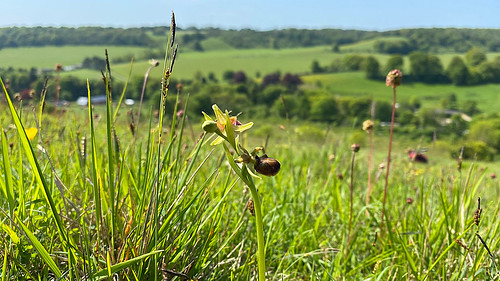 The Green Fly did return, three spikes in the end, though I just went the once to show an elderly gentleman and his wife the plant. He was an orchidist of several decades, and had never seen one before
The Green Fly did return, three spikes in the end, though I just went the once to show an elderly gentleman and his wife the plant. He was an orchidist of several decades, and had never seen one before Just as good news was the increased numbers of Neottia nidus-avis at the usual reliable site. But took until 21st May for the first spike to show.
Just as good news was the increased numbers of Neottia nidus-avis at the usual reliable site. But took until 21st May for the first spike to show. Numbers of Cephalanthera damasonium also up on previous years, though I only saw this one spike in flower.
Numbers of Cephalanthera damasonium also up on previous years, though I only saw this one spike in flower.
 But 2023 will best be remembered as the year of the Late Spider, with two new sites found for me, and several unusual spikes seen, incuding two yellow ones, mis-shapen flowers and odd-marked lip. All down to the hunt for the green flowered found by others, which we did fail to find, but the thrill, as ever, was in the hunt.
But 2023 will best be remembered as the year of the Late Spider, with two new sites found for me, and several unusual spikes seen, incuding two yellow ones, mis-shapen flowers and odd-marked lip. All down to the hunt for the green flowered found by others, which we did fail to find, but the thrill, as ever, was in the hunt.
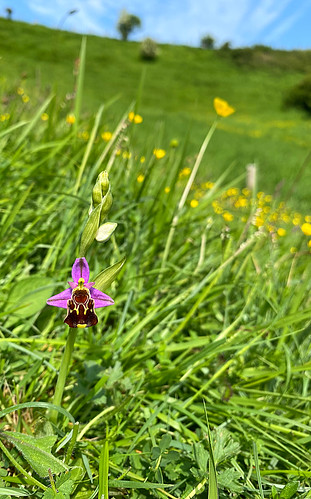 Orchis simia were seen in good numbers, though I did not have time to get to the Faversham site, PGD delivered large numbers, including this fine pair. Though the season was two weeks later than has been in recent years.
Orchis simia were seen in good numbers, though I did not have time to get to the Faversham site, PGD delivered large numbers, including this fine pair. Though the season was two weeks later than has been in recent years. The unique Dover Bee, Ophrys apifera var. dubrisii, returned at the end of May, and going late in the day, I was alble to snap it in bright sunlight, best to show its colours off.
The unique Dover Bee, Ophrys apifera var. dubrisii, returned at the end of May, and going late in the day, I was alble to snap it in bright sunlight, best to show its colours off.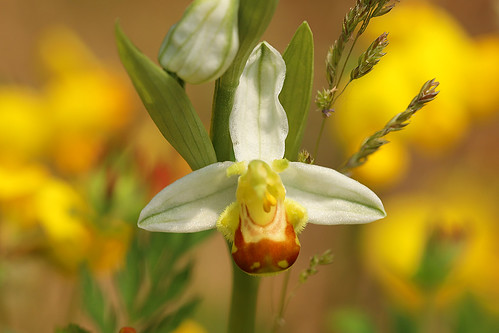 One last highlight was the return of the Kentish Burnt (Tip), Neotinea ustulata, seen on a grim, cold and wet morning. What was I doing, I told myself, walking again up and down the down looking for a plant that I knew wasn't there. And suddenly, there it was. Aching legs and being soaked were forgotten in the joy of the tiny brightly coloured spike. A second spike was found further up the down by others, so the tiny colony persists. For now.
One last highlight was the return of the Kentish Burnt (Tip), Neotinea ustulata, seen on a grim, cold and wet morning. What was I doing, I told myself, walking again up and down the down looking for a plant that I knew wasn't there. And suddenly, there it was. Aching legs and being soaked were forgotten in the joy of the tiny brightly coloured spike. A second spike was found further up the down by others, so the tiny colony persists. For now. Upon our return from Svalbard, the season was still going strong, but some spikes were already going to seed. A tip off took me to north Kent to see a colony of four Dactylorhiza fuchsii var. rhodochila, as well as several strongly marked spikes on top of that!
Upon our return from Svalbard, the season was still going strong, but some spikes were already going to seed. A tip off took me to north Kent to see a colony of four Dactylorhiza fuchsii var. rhodochila, as well as several strongly marked spikes on top of that! Another tip off sent me to mid-Kent to see a previously unreported site for Platanthera bifolia. We got to OK from a local gamekeeper to go on, and were rewarded with a spike some 68cm tall, not bad for a plant that shouldn't get over 30cm!
Another tip off sent me to mid-Kent to see a previously unreported site for Platanthera bifolia. We got to OK from a local gamekeeper to go on, and were rewarded with a spike some 68cm tall, not bad for a plant that shouldn't get over 30cm! By then, news of the Green Late Spider had leaked out, so off we went searching. As I said before, I must have seen 300 spikes, some of shape, size, colour and patternation I have not seen before. It was quite the blast, hoping that the next plant we would find would be green. Not green, but the occasional yellow soike, if not flowers.
By then, news of the Green Late Spider had leaked out, so off we went searching. As I said before, I must have seen 300 spikes, some of shape, size, colour and patternation I have not seen before. It was quite the blast, hoping that the next plant we would find would be green. Not green, but the occasional yellow soike, if not flowers.

 And another hybrid was found, but this one a possible backcrossed hybrid with a Bee, Ophrys x albertiana x apifera. A stunning little plant, though we'll never know for sure if it is.
And another hybrid was found, but this one a possible backcrossed hybrid with a Bee, Ophrys x albertiana x apifera. A stunning little plant, though we'll never know for sure if it is.
 Our garden Pyramidals returned, two spikes where we had had them previously, but a third appeared about six feet away. And good news is that all three rosettes are already showing well for the 2024 season.
Our garden Pyramidals returned, two spikes where we had had them previously, but a third appeared about six feet away. And good news is that all three rosettes are already showing well for the 2024 season.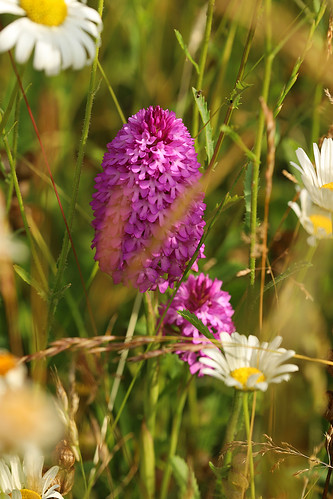 Numbers of Epipactis helleborine recovered further that their mid-Kent site, with spikes reappearing in the centre of the meadow around the mature trees, and dark ones further up the down right by the treeline.
Numbers of Epipactis helleborine recovered further that their mid-Kent site, with spikes reappearing in the centre of the meadow around the mature trees, and dark ones further up the down right by the treeline.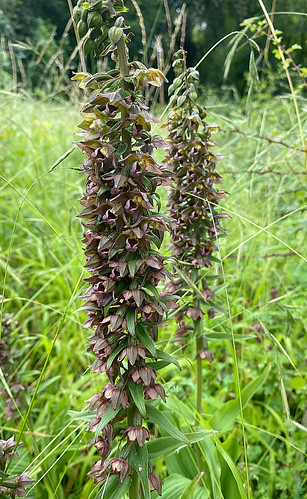 At Sandwoch Bay, numbers of Epipactis palustris are also increasing, with the spikes spreading to other area of the fenced off slacks.
At Sandwoch Bay, numbers of Epipactis palustris are also increasing, with the spikes spreading to other area of the fenced off slacks. Final highlight was a triple spike of Epipactis purpurata var chlorantha, or Violet Helleborine lacking pigmentation. Found in a little known wood, news of these soon reached far and wide.
Final highlight was a triple spike of Epipactis purpurata var chlorantha, or Violet Helleborine lacking pigmentation. Found in a little known wood, news of these soon reached far and wide. That leaves just the Autumn Lady's Tresses which showed well on the downs again, though in reduced numbers, probably due tot he wet spring and summer causing increased competition from other plats that had usually been brined to a crisp by then.
That leaves just the Autumn Lady's Tresses which showed well on the downs again, though in reduced numbers, probably due tot he wet spring and summer causing increased competition from other plats that had usually been brined to a crisp by then.

No comments:
Post a Comment